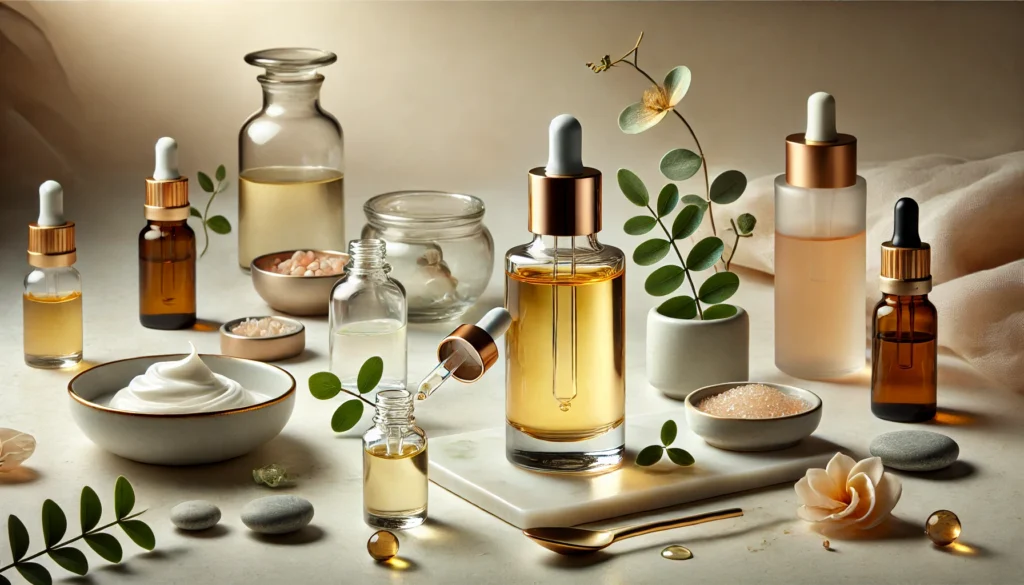When it comes to skincare, and our expertise in Japanese skincare, we’ve tried countless ingredients, but two that really stand out are lactic acid and retinol. They’re game-changers for smoother, brighter, and healthier skin.
The tricky part is knowing how to use them properly. That’s where we come in—thanks to our experience with Japanese beauty routines, we know how to get the best results without irritating your skin.
In this guide, we’ll show you what lactic acid and retinol are, why they’re so popular, and how you can safely use them together or separately. And of course, we’ll share a few Japanese skincare tricks to help you make the most out of these powerhouse ingredients!
– Benefits of lactic acid and retinol: Lactic acid smooths and brightens, while retinol reduces fine lines and stimulates collagen.
– How to use them without irritation: Start slow, alternate their use, and don’t forget sunscreen.
– Japanese techniques for better results: Focus on balance, hydration, and consistency for long-term skin health.

1. What is Lactic Acid?
Lactic acid is one of our favorite gentle exfoliants. It’s an AHA (alpha hydroxy acid) that works wonders on the skin by sloughing off dead cells while keeping things hydrated.
What we love about it is that, unlike harsher acids, lactic acid not only exfoliates but also attracts moisture, making it ideal for sensitive or dry skin.
In Japanese skincare, hydration is key, and lactic acid fits perfectly into that philosophy—it smooths the skin without stripping it of its natural moisture.
1.1 Key Benefits of Lactic Acid
- Gentle exfoliation: We’ve seen how lactic acid gently removes dead skin, leaving it smoother and softer.
- Brightens skin tone: If you’re dealing with dark spots or dull skin, lactic acid can help even things out and boost your glow.
- Hydration boost: Unlike other exfoliants that leave your skin dry, lactic acid locks in moisture, making your skin feel plump and fresh.
This balance of exfoliation and hydration is why it’s a must-have in any routine, especially if you have dry or sensitive skin.
1.2 How Lactic Acid Works on the Skin
Lactic acid works by loosening the bonds that hold dead skin cells together. Once those cells are gone, your skin feels smoother and looks brighter.
We’ve noticed that when you use lactic acid regularly, your skincare products absorb better because there’s no dead layer blocking them.
And the hydration part? That’s because lactic acid is a humectant—it pulls moisture into your skin, making it softer and less prone to dryness.
1.3 Ideal pH Levels for Lactic Acid Use
To get the most out of lactic acid, you want a product with a pH around 3.5 to 4.0. At this pH, it’s strong enough to exfoliate without irritating your skin.
Japanese brands often formulate their lactic acid products to be both effective and gentle, balancing exfoliation with hydration to keep your skin happy.

2. What is Retinol?
Retinol is a classic ingredient in anti-aging skincare, and for good reason. It speeds up your skin’s natural cell turnover, helping to smooth out fine lines, fade dark spots, and prevent breakouts. But here’s the thing—we’ve learned that retinol can be a little tricky to use, especially if you’re new to it or have sensitive skin.
That’s why in Japanese beauty, retinol products are often paired with soothing ingredients like squalane or ceramides to reduce irritation while still delivering results.
2.1 Key Benefits of Retinol
- Reduces wrinkles: Retinol encourages collagen production, which helps smooth out fine lines and keep your skin firm.
- Prevents acne: It clears out pores by speeding up how quickly your skin sheds dead cells, reducing the chance of breakouts.
- Improves texture: With regular use, retinol can even out rough patches and give your skin a smoother finish.
We’ve seen amazing long-term results with retinol, but it’s important to introduce it slowly into your routine to avoid irritation.
2.2 How Retinol Works on the Skin
Retinol works deeper in the skin compared to lactic acid. Once applied, it gets converted into retinoic acid, which signals your cells to produce more collagen and renew themselves faster. This is what makes it such a powerful ingredient for tackling fine lines, acne, and uneven skin tone.
One thing to keep in mind? Retinol can make your skin more sensitive, especially to the sun, so always follow up with sunscreen during the day.
2.3 Ideal pH Levels for Retinol Use
For retinol to work well, you want to keep it at a neutral pH around 5.5 to 6.0. This ensures it penetrates deep enough to stimulate cell renewal without causing too much irritation.
In Japanese skincare, it’s common to combine retinol with calming oils or barrier-strengthening ingredients to minimize redness and dryness.
Now that we’ve covered what makes lactic acid and retinol so effective, the next big question is: Can you use them together? Spoiler alert—it’s not as simple as slapping them on at the same time.

3. Can You Use Lactic Acid and Retinol Together?
We get asked this a lot, and we get it—both lactic acid and retinol are powerful skincare ingredients. But here’s the thing: while they can do wonders on their own, using them together isn’t always the best idea.
Why? It all comes down to how they work and what they need to be effective.
3.1 Why They Don’t Mix Well
Both ingredients have different pH requirements to work properly. Lactic acid thrives in a low pH environment (around 3.8) where it gently exfoliates the skin.
Retinol, on the other hand, prefers a more neutral pH (around 6), where it can penetrate deeper into the skin and stimulate collagen production.
When you mix them at the same time, lactic acid’s acidic environment can destabilize retinol, making it less effective. Worse, it increases the chances of irritation, especially if your skin is on the sensitive side.
3.2 Risks of Combining Lactic Acid and Retinol
Combining both without proper care can lead to:
- Redness and burning: Too much exfoliation at once can irritate your skin.
- Dryness and peeling: Overdoing it with active ingredients can strip your skin, leading to flaking.
- Increased sensitivity to sunlight: Both ingredients already make your skin more sensitive to UV rays, so using them together amplifies this risk.
The good news is you don’t have to give up on either. You just need to know how to use them smartly.
3.3 How to Alternate Them Safely
In Japanese skincare, balance is everything. We suggest alternating their use:
- Lactic acid in the morning: It gently exfoliates your skin, giving you a smooth, fresh canvas for the day. Just make sure to apply sunscreen afterward.
- Retinol at night: Your skin goes into repair mode while you sleep, making this the perfect time to apply retinol and let it do its thing.
Alternatively, you can use them on different days—for example, lactic acid on Mondays and Wednesdays, and retinol on Tuesdays and Thursdays.
This method gives your skin time to adjust and reduces irritation.

4. Best Practices for Using Lactic Acid and Retinol
Using strong actives like lactic acid and retinol requires care. When done right, they’ll leave your skin looking radiant without unnecessary irritation.
4.1 Separate Application Times
We recommend applying lactic acid in the morning and retinol at night. This helps prevent pH clashes and ensures each ingredient works at its best. If you want to use both at night, apply them on alternate nights rather than layering them together.
4.1 Performing a Patch Test
Before adding either ingredient to your routine, always do a patch test. Apply a small amount behind your ear or on your jawline and wait 24 hours. If there’s no irritation, you’re good to go!
4.3 Start Slowly and Increase Gradually
When introducing powerful actives like these, less is more at first. Use lactic acid or retinol once or twice a week, then gradually increase the frequency as your skin builds tolerance. This way, you’ll avoid irritation while still getting great results.

5. Potential Side Effects and How to Avoid Them
Even with proper care, lactic acid and retinol can sometimes cause side effects. Here’s what to watch out for and how to manage them.
5.1 Common Side Effects
- Redness and irritation: Over-exfoliation or using too much retinol can lead to temporary redness and discomfort.
- Peeling and dryness: Both ingredients speed up skin turnover, which can cause some peeling.
- Increased sun sensitivity: Your skin becomes more prone to sun damage, so extra protection is key.
5.2 How to Minimize Side Effects
We’ve found that following these steps helps reduce irritation:
- Moisturize generously: Hydration is key when using actives. Look for moisturizers with hyaluronic acid or ceramides to strengthen your skin barrier.
- Always wear sunscreen: Both lactic acid and retinol increase sun sensitivity, so using a broad-spectrum sunscreen with SPF 30 or higher is non-negotiable.
- Don’t rush it: Start slow, and listen to your skin. If it feels irritated, give it a break and reduce the frequency.

6. Japanese Skincare Tips for Lactic Acid and Retinol
In Japanese skincare, the focus is always on balance and long-term results. Here’s how we recommend incorporating these powerful ingredients into your routine:
6.1 Using Lactic Acid for Brightening
Lactic acid is a favorite in Japan for its gentle exfoliation and hydrating properties. Applying it in the morning can give your skin a smooth, glowing base for the day. Just don’t forget sunscreen afterward!
6.2 Incorporating Retinol into an Anti-Aging Routine
Retinol is best reserved for nighttime when your skin is in repair mode. A low-concentration retinol works well for beginners. And remember, Japanese beauty emphasizes consistency, so don’t expect overnight miracles—slow and steady wins the race.
6.3 Alternating Lactic Acid and Retinol in a Weekly Routine
One trick we swear by? Alternate them throughout the week. For example, use lactic acid on Monday and Wednesday and retinol on Tuesday and Thursday. This way, your skin gets the benefits of both without the risk of irritation.
By following these steps, you’ll be able to harness the full potential of lactic acid and retinol while keeping your skin happy and healthy. Remember, a well-thought-out routine makes all the difference!
FAQ
What are the main benefits of lactic acid for the skin?
Lactic acid gently exfoliates the skin, improves texture, and helps reduce pigmentation. It also has moisturizing properties, making it ideal for those with dry or sensitive skin. Regular use leads to smoother, brighter, and more even-toned skin.
Is it safe to use lactic acid every day?
It depends on your skin’s sensitivity. If you’re new to lactic acid, we suggest starting with 1-2 times a week. Once your skin builds tolerance, you can gradually increase usage. For sensitive skin types, alternate days might be more suitable.
When is the best time to apply retinol?
Nighttime is the best time to apply retinol. During the night, your skin’s natural repair process is active, making it an ideal time for retinol to work on boosting collagen production and cell turnover.
Can I use lactic acid in the morning?
Yes, you can use lactic acid in the morning, but make sure to apply sunscreen afterward. Since lactic acid exfoliates the skin, it makes your skin more sensitive to UV rays.
How long does it take for retinol to show visible results?
It typically takes 4-6 weeks to see noticeable improvements when using retinol consistently. For anti-aging effects like reduced fine lines, it may take 12 weeks or more. Patience and consistency are key!
Table of Contents
